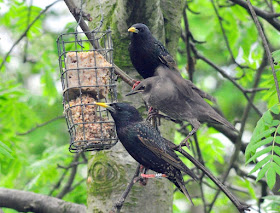While catching Starlings over the past few days I have been playing with a small action camera rather than the usual dslr and long lens. The following videos are the best of my initial attempts and were set up to show the antics of the birds but they also show the camera's potential for reading the numbers on the colour-rings. Now I know what it is capable of I will certainly be using it to record the numbers on the colour-ringed adults next year.
Bathing often seems to be infectious in gregarious species like Starlings; once one starts others soon join in. There is a bit of a lull in the action in the middle of the video but it picks up again towards the end.
The meal worm rich fat cakes are a highly prized food source and the birds are currently eating their way through about 2 kg of home made fat cakes each week.
The final video is with the camera set up in the trap that I use to catch all of my Starlings for ringing. The camera isn't set up in a very good position (it was my very first attempt) but it shows how freely birds come and go after some initial wariness of the camera and curiosity in seeing their refection on the plastic housing. There are three funnel entrances in addition to the entrance in view so that is why more birds leave than can be seen entering.























